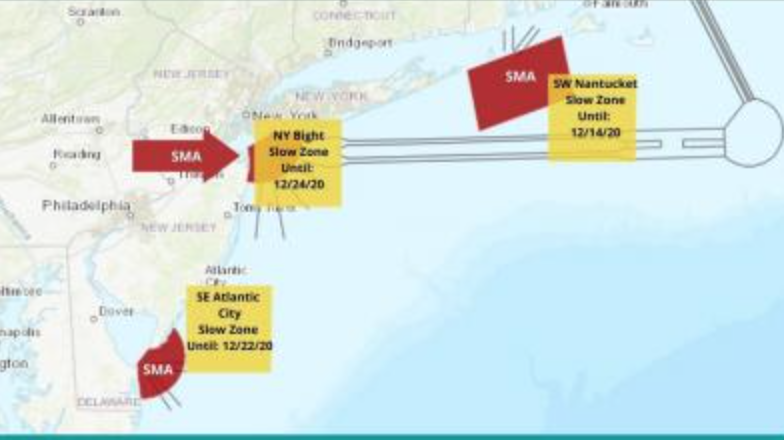An analysis of automated ship tracking data shows that nearly 90 percent of vessels transiting mandatory speed zones to protect endangered northern right whales are violating the speed limits, according to a new report.
The highest level of compliance ¬– with about one-third of vessels obeying the 10-knots limit – was documented in the Off Race Point seasonal management area, near Cape Cod, Mass., where NOAA regularly announces speed restrictions to protect migrating whales.
The lowest levels of compliance – with nearly 90 percent of vessels busting the 10-knot limit – was off the coast between Wilmington, N.C., and Brunswick, Ga. That reach includes approaches to the burgeoning ports of Charleston, S.C. and Savannah, Ga., where cargo traffic and container ship sizes are growing.
“If NOAA is serious about its mandate to save North Atlantic right whales from extinction, speed zones must be designated in the areas where whales currently are, and they must be enforced,” said Whitney Webber, campaign director at the environmental group Oceana, which compiled the analysis using Automatic Identification System data from 2017 to 2020. “Until speed zone rules are mandatory and violators held accountable, North Atlantic right whales will continue to die on NOAA’s watch.”
The AIS data comes via Global Fishing Watch, an international nonprofit organization founded by Oceana in partnership with Google and SkyTruth. That database recently yielded another report about foreign squid fishing vessels mounting apparent incursions into Argentina’s exclusive economic zone.
The new findings also back up an earlier analysis by NOAA itself, reported in January 2021. For the right whale study, Oceana analyzed self-reported vessel speeds and location data to track vessel speeds and positions in North Atlantic right whale conservation areas.
NOAA delineates two types: seasonal management areas, based on previously documented right whale movements, where the 10-knot is mandatory, and dynamic management areas, announced as whales are tracked by NOAA aerial surveys and vessel report, where 10 knots is recommended.
With only an estimated 366 animals left, the northern right whale is one of the most endangered species on Earth, with ship strikes and fishing gear entanglement considered the top threats.
The analysis showed non-compliance was as high as almost 90 percent in mandatory speed zones, and non-cooperation was as high as almost 85% in voluntary areas.
“While this analysis focused on vessels 65 feet or larger that are required to use public tracking devices, vessels of all sizes can cause fatal injuries to North Atlantic right whales,” the report states, noting a 2021 case when a right whale calf died of propeller wounds, broken ribs and a fractured skull after a collision with a recreational boat.
Among other findings, the group reported seasonal management areas with the worst compliance on mandatory speed limits were:
- Wilmington, N.C. to Brunswick, Ga., with almost 90 percent non-compliance.
- The port of New York and New Jersey, almost 80 percent not complying.
- Right whale calving and nursery grounds off Georgia and Florida, where more than 70 percent of vessel transits exceeded the limit
. - The entrance to the Chesapeake Bay, almost 65 percent non-compliance, and the entrance to Delaware Bay, with more than 55 percent of vessels over the limit.
Two-thirds of the vessels that exceeded 10-knot speed limits in both DMAs and SMAs operated under foreign flags, according to Oceana, which scored the worst offenders as sailing under the flags of the United States, Panama, Marshall Islands, Liberia, Germany, and Singapore.




